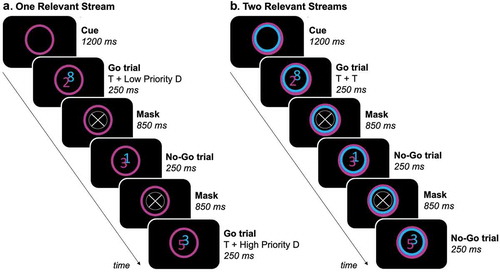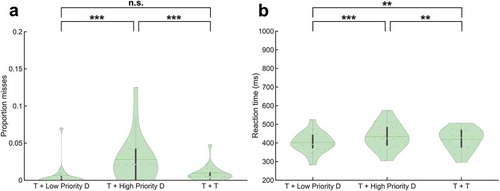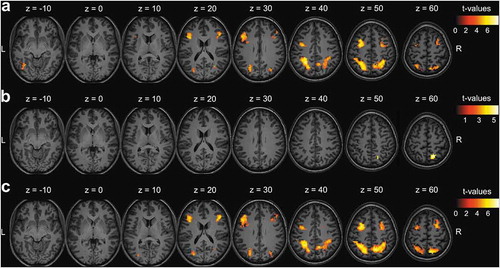Figures & data
Figure 1. Feature-based variant of the sustained attention to response task. The task-relevant stream(s) was/were indicated by a colored circle. Participants were instructed to press a button on a response box when a target (digit ≠ ‘3ʹ) appeared in the task-relevant stream(s) (= go trials), but had to inhibit the response when a non-target (digit = ‘3ʹ) appeared in a task-relevant stream (= no-go trials). (a) In experimental blocks where only one stream of digits was task-relevant, two types of go trials occurred: target (T) (task-relevant digit ≠ ‘3ʹ) with high (task-irrelevant digit = ‘3ʹ) or low (task-irrelevant digit ≠ ‘3ʹ) priority distracter (D). (b) In experimental blocks where both streams of digits were task-relevant, only one type of go trial occurred (T + T) (both digits ≠ ‘3ʹ).

Table 1. Experimental conditions.
Figure 2. Behavioral results. (a) Proportion misses, and (b) Reaction times on go trials. * = p < .05, ** = p < .01, *** = p < .001, n.s. = not significant (p > .05). Abbreviations: ‘T’ = Target, ‘D’ = Distracter.

Table 2. Significant clusters in (a) Contrast 1: effect of increasing distracter priority, (b) Contrast 2: effect of selecting one (low priority distracter) versus attending two stream(s) of stimuli, and (c) Contrast 3: effect of selecting one (high priority distracter) versus attendingtwo stream(s) of stimuli.
Figure 3. fMRI results. (a) Contrast 1: effect of increasing distracter priority, (b) Contrast 2: effect of selecting one (low priority distracter) versus attending two stream(s) of stimuli, and (c) Contrast 3: effect of selecting one (high priority distracter) versus attending two stream(s) of stimuli. Results of correct responses on go trials presented as statistical t-maps in MNI (Montreal Neurological Institute) space. Cluster-extent based thresholding was used with voxel-based threshold uncorrected p < .001 and cluster-based threshold FWE (familywise error)-corrected p < .05.

